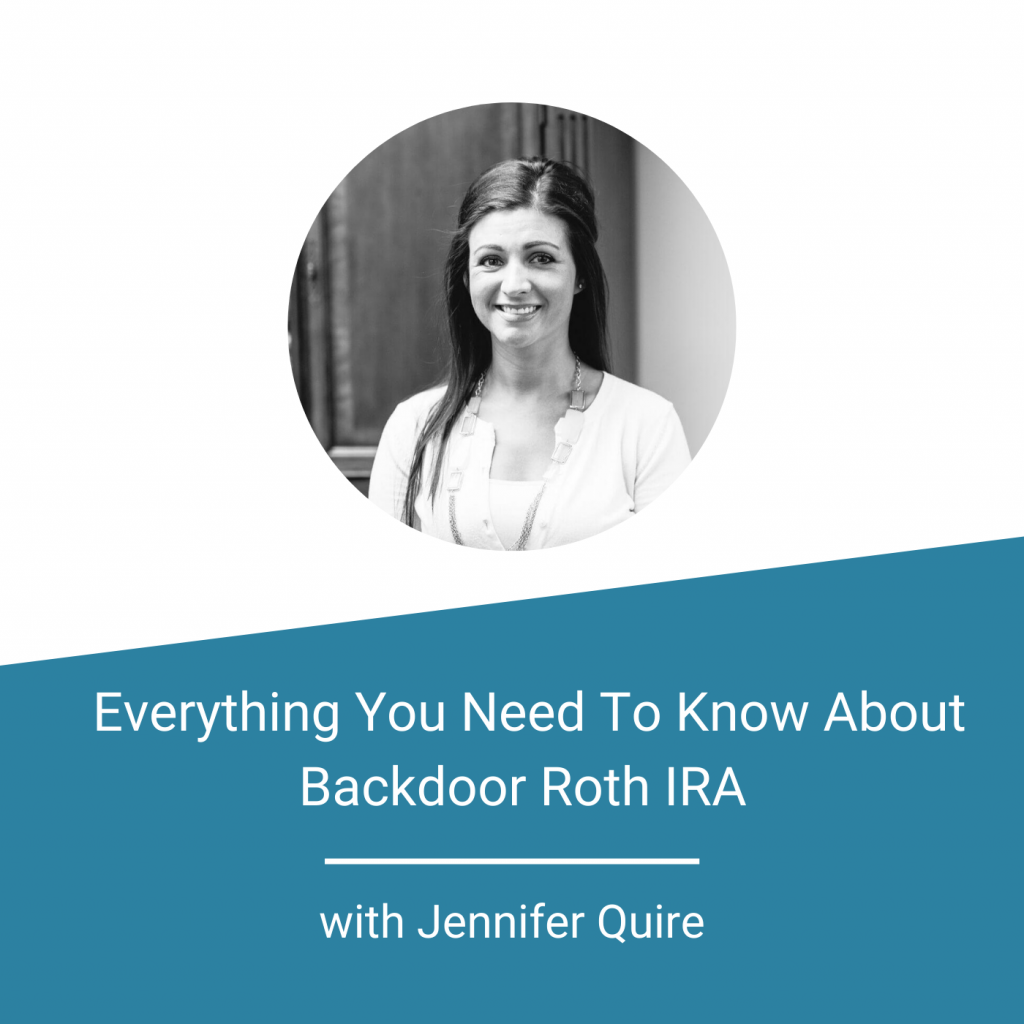Why should physicians in practice consider a Backdoor Roth IRA? Make sure to do it correctly and efficiently to get the greatest benefits.
In this episode of the Finance For Physicians Podcast, Daniel Wrenne talks to Jennifer Quire about the Backdoor Roth IRA. Jennifer is Daniel’s colleague at Wrenne Financial Planning and a fellow Certified Financial Planner CFP®.
Topics Discussed:
- When to consider the “back-door” Roth IRA instead of the normal Roth IRA
- Steps to take to go through the “Back-door”
- Common mistakes to avoid
- Step Transaction Doctrine: No multiple steps allowed to circumvent IRS’s rules
- What is the pro-rata rule and why is it important to watch out for?
- Why is the Roth IRA beneficial to physicians and others?
- Serves as additional option for tax favored retirement savings
- Provides tax diversification (future tax-free withdrawals)
- No Required Minimum Distributions “RMD”s required on Roth IRAs
- Often provides additional creditor protection
- Verify Form 8606 is included in your federal tax return
- Verify that line 4b is correct on your Form 1040 (main form in federal tax return)
- Verbally notify your accountant that you’re funding the back-door Roth IRA
- Save the Form 5498 (verifies funding) and Form 1099-R (verifies Roth Conversion)
Links & Bonus Content:
Backdoor Roth: A Complete How-To
Backdoor Roth IRA 2020: A Step by Step Guide with Vanguard
Backdoor Roth IRA Ultimate Guide and Tutorial
17 Ways To Screw Up A Backdoor Roth IRA
Step Transaction Doctrine – IRS
Full Episode Transcript:
Daniel Wrenne:
0:00:08
Jen and I are back at it again today talking about the Backdoor Roth IRA. Before we get into that, let me give you the quick and dirty skinny on the Backdoor Roth IRA. It’s typically a very beneficial tax shelter for physicians, especially those in practice. We’re going to be discussing when you should consider it, the steps required to fund it, and the most common mistakes we see that you’re all going to want to avoid. If you’re not familiar with the Backdoor Roth, or you want to make sure you’re doing it correctly, or maybe you just want a refresher on it, you’re definitely going to benefit from today’s episode. Jen, what’s up? Thanks for taking the time to chat today.
Jennifer Quire:
00:01:00
Yeah, glad to be here.
Daniel Wrenne:
00:01:02
Awesome. Today we are going to be talking about the backdoor Roth IRA, how it all works and go through that process. I think a good starting point on the Backdoor Roth is just to get into what it is. What exactly is a Backdoor Roth IRA? Jen, can you give us the low down?
Jennifer Quire:
00:01:22
Yeah. I’m sure most people have heard of a regular Roth IRA before and might even know that whether or not you’re able to contribute to it has to do with your income. Specifically, your modified AGI, which is around $200,000 for married filing joint people. If you’re over that limit, you’re out of luck, you’re not able to contribute to it.
Daniel Wrenne:
00:01:46
Directly?
Jennifer Quire:
00:01:47
Yeah, directly to it. But fortunately, there’s a work around for the high-income earners who would have otherwise not been able to contribute to it. Enter the Backdoor Roth IRA. Instead of contributing directly to the Roth, you basically just take an extra step. You have a nondeductible IRA that you contribute to first. Then from there you do a Roth conversion that moves the money from the nondeductible IRA to the Roth IRA. In the end, it’s the same thing, you’re still contributing to the Roth IRA, you just have to take an extra step along the way. You’re essentially just backdooring the contribution into the Roth. They should change the name, it sounds shady, but it’s fine, it’s just a backdoor.
Daniel Wrenne:
00:02:32
Yeah. I think they’ve even released some revenue rulings or something along those lines that confirms that the IRS-
Jennifer Quire:
00:02:41
Yeah. I was actually reading about it. One of the IRS guys had made–it wasn’t a ruling, he had come out and said, “The step-transaction doctrine basically says you can get in trouble if we think what you’re doing is trying to bypass our rules. But in the case of the backdoor Roth IRAs, we don’t consider that to be a violation.” So, it’s good.
Daniel Wrenne:
00:03:08
Yeah, the step-transaction doctrine is the IRS rule that says you can’t take multiple steps to circumvent our rules.
Jennifer Quire:
00:03:17
Yeah.
Daniel Wrenne:
00:03:18
That’s definitely good news. Basically, it legitimizes this whole process. So, the Roth IRA, why is it so beneficial to physicians?
Jennifer Quire:
00:03:31
Well, and I think to physicians and really anyone, it’s an additional option for retirement savings after you’ve maxed out anything you have through work. It’s a retirement savings option for an unemployed spouse, if that’s an option for you. It provides tax diversification for your retirement assets. There’s no RMDs on Roth IRAs. They provide asset protection up to certain limits in most states. Any benefits I’m missing? I think that’s most of-
Daniel Wrenne:
00:04:04
Basically the high-income physician is typically maxing everything out. This is just another way to further shelter money from taxes, which is always good.
Jennifer Quire:
00:04:18
Especially when the alternative would likely have been just an after-tax taxable account.
Daniel Wrenne:
00:04:24
Let’s talk about the considerations to think about before you actually go through this process. It sounds simple. Maybe. I think it sounds simple, it’s really just an extra step. It seems like people get hung up, there are a lot of errors that happen along the way. What are the big considerations to throw out there before you actually fund it?
Jennifer Quire:
00:04:55
One of the main things you want to look out for and one of the things we run into a lot with our clients is, in order to do it the most efficiently tax wise, you really don’t want to have any traditional IRA dollars in place. That’s your traditional IRAs, your SEP IRAs, your simple IRAs. If you have any of those in place, ideally we want to make a plan for moving those around before we start using the Backdoor Roth IRA strategy, otherwise some complicated tax pro rating comes into play.
Daniel Wrenne:
00:05:30
Yeah, and that’s the pro-rata rule, right, Jen?
Jennifer Quire:
00:05:32
Yeah.
Daniel Wrenne:
00:05:33
Ideally, you don’t have to worry about that. The way you do that is you just clear out all your IRAs, or maybe you don’t even have any in the first place.
Jennifer Quire:
00:05:45
Most people that we work with, have some sort of way to clean it up. If you have a 401(k) or a 403(b) with work, and you have an old traditional IRA that you had rolled over from an old retirement plan that you had, usually you can just take that IRA and consolidate it into your current 401(k) or 403(b) (check your specific plan rules for confirmation on this). You can just roll it over and that’s how we clean it up. Or if you’re self-employed, you can roll it over into your solo 401(k). There’s usually an option for moving it around. That’s kind of the ideal setup is that we can just roll it into one of your existing, non-IRA pre-tax accounts.
Daniel Wrenne:
00:06:25
Just to make sure it’s all clear, the first step is to verify that the pro-rata rule is not an issue. If it is, you need to clear out your existing IRAs. You’ve got to always think about the tax consequences. If you can transfer the existing IRA into a place that has really no tax effect, that’s the key there. Once you clean all that up, let’s talk through the next steps. Then you’ve got to open up a new account if you don’t have one. You have to make sure you have both a traditional IRA and a Roth IRA, if they don’t already exist. From there, Jen, what’s next? Do you fund the traditional IRA?
Jennifer Quire:
00:07:11
Yeah, you’re going to fund the traditional IRA and then you’re going to move money from the traditional IRA to the Roth IRA. Usually what that looks like is filling out a form called a Roth Conversion Form that you submit to whatever company you’re using that just says, “Hey, I would like to move my money from my IRA to my Roth.” That essentially performs the Roth conversion for you. Moves it from the traditional IRA over to the Roth IRA.
Daniel Wrenne:
00:07:37
Once you do that, you’ve got to make sure to invest the money. We’ve seen lots of people forget this step. And then the last step is just to get it reported on your taxes. What’s the form, Jen?
Jennifer Quire:
00:07:53
It’s 8606.
Daniel Wrenne:
00:07:55
We’ll link the form that you complete. Besides some of the things we’ve pointed out already, what are some of the most common issues that you see as people work through this process?
Jennifer Quire:
00:08:09
I know we already mentioned the pro-rata rule if you have any traditional IRA dollars in place. The reason we want to avoid that is because you end up paying tax that we don’t want you to have to pay. The IRS isn’t going to let you cherry pick only your after tax IRA contributions if you have a bunch of pre-tax IRA dollars already in place. They’re going to make you take a prorated portion of the after tax to pre-tax balances of your total balance. They make you look at everything together and consider that to be one total IRA balance. You’ll have to pay tax based on the pro-rating there. Ideally, we avoid that all together, but not everyone realizes that that’s a rule. We also see it reported incorrectly on taxes all the time. I would say of clients that are using this strategy, what would you say 50% of the tax returns we see are wrong? Maybe?
Daniel Wrenne:
00:09:07
Yeah, that would be my guess, it might be more.
Jennifer Quire:
00:09:10
So really what you want to look for if you’re using this strategy, you want to look at line 4b on your 1040.
Daniel Wrenne:
00:09:17
So, 1040 is the main tax form.
Jennifer Quire:
00:09:19
Yeah, 1040 is the main form of your tax return. The summary page. Line 4b, ideally should be zero, unless that pro-rata rule is coming into play with you, which ideally is not.
Daniel Wrenne:
00:09:35
Now, line 4b might be a few hundred dollars, I think that’s okay.
Jennifer Quire:
00:09:40
Yeah, if you’ve had some gains.
Daniel Wrenne:
00:09:42
If you put it in the traditional IRA and then it goes up a little bit, and then you convert it, there can be some gains there.
Jennifer Quire:
00:09:51
But it shouldn’t be $6,000.
Daniel Wrenne:
00:09:53
Right. Or $12,000. That’s definitely a common error. We’ll look at the tax return and see that it’s showing as $12,000 of income and that’s completely incorrect. Maybe that’s a $4,000 mistake (depending on your circumstances) on average.
Jennifer Quire:
00:10:20
As you’ve pointed out before, even more, if you’ve then used that tax return to verify income on your student loans it can have a trickle down negative effect.
Daniel Wrenne:
00:10:37
The good news is if you do catch it you can amend tax returns for up to three years, and fix it. Ideally you catch that on the front end. You just want to, first of all, make sure the Form 8606 is complete in the first place. We’ve seen a lot of them where they just don’t complete the form. Then second of all, that it’s coming through correctly where it’s not showing that full amount as income. The reason it happens is they just did that form incorrectly. The 8606 is a confusing form.
Jennifer Quire:
00:11:12
I think the backdoor Roth IRAs fortunately is becoming a little bit more widely known as a strategy. We’ve had a few battles with CPAs over the years, but it’s becoming more widely known. Part of the confusion is when people process the conversion and then–we use TD Ameritrade, for example–when TD Ameritrade sends out those 1099-Rs, it says, “Hey, this client did this Roth conversion”. And then the client gives that 1099-R to their accountant. The accountant sees the box that says $6,000 was distributed. Then there’s a box that is checked “taxable” and then there’s another box that’s checked “taxable amount was not determined”. Usually, the CPA just assumes that it was all taxable and if the client’s not sure, that’s how this issue occurs a lot. So always double check on that line.
Daniel Wrenne:
00:12:08
One more side note, there are a few tax forms that get spit out from this whole process and they are going to be coming from the investment company or the custodian that holds the funds. You always want to keep those for your records. They’re kind of like your proof of the transactions in case you’re audited. The first form is an informational form that says you made the contribution to the traditional IRA and it is Form 5498. The problem with that form is it doesn’t come until May, right Jen?
Jennifer Quire:
00:12:46
Yeah, after you’ve done your taxes.
Daniel Wrenne:
00:12:48
So it’s after you’ve done your taxes because the deadline to fund is the tax deadline. So they then create the forms after. If you use an accountant, the accountant’s not going to know that you contributed to the traditional IRA unless you verbally tell them. You always have to verbally tell them, and you always want to save that form for future reference and proof of the contribution. The second form is the 1099. That happens when you convert from traditional IRA to Roth IRA. That gets created at the beginning of the year following the conversion and you just want to keep it on file. All right, Jen, thanks for chatting with me about this and I appreciate you going through the process.
Jennifer Quire:
00:13:35
I was happy to be here. I’m excited to officially be a podcast guest.
Daniel Wrenne:
00:13:39
As always, thank you so much for joining us today. If you found this valuable, please give us a review on iTunes and share with a friend. Also check out our website at www.financeforphysicians.co for all sorts of additional content. See you next time.
Finance for Physicians is not an investment tax, legal or financial advisor. All content included in this podcast is for informational purposes only and should not be considered financial, tax or legal advice. Material presented is believed to be from reliable sources and no representations are made by Finance for Physicians as to another party’s informational accuracy or completeness. All information or ideas provided should be discussed in detail with an advisor, accountant or legal counsel priority to implementation. If you don’t have an advisor or like a second opinion, feel free to check out our website for recommended advisors.









